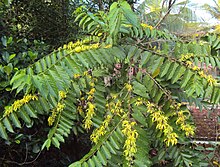
Back Seulanga ACE يلانج Arabic يلانج ARZ Cananga odorata AST Sandat BAN Tangid BCL Kembang kuburan BEW Иланг-иланг Bulgarian অপরূপ চাঁপা Bengali/Bangla Ilang-ilang Catalan
| Ylang-ylang | |
|---|---|

| |
| Cananga odorata in bloom | |
| Scientific classification | |
| Kingdom: | Plantae |
| Clade: | Tracheophytes |
| Clade: | Angiosperms |
| Clade: | Magnoliids |
| Order: | Magnoliales |
| Family: | Annonaceae |
| Genus: | Cananga |
| Species: | C. odorata
|
| Binomial name | |
| Cananga odorata | |

Cananga odorata, known as ylang-ylang (/ˈiːlæŋ ˈiːlæŋ/ EE-lang-EE-lang) or cananga tree, is a tropical tree that is native to the Philippines, Malaysia, Indonesia, New Guinea, the Solomon Islands, and Queensland, Australia. It is also native to parts of Thailand and Vietnam.[1] It is valued for the essential oils extracted from its flowers (also called "ylang-ylang"), which has a strong floral fragrance. Ylang-ylang is one of the most extensively used natural materials in the perfume industry, earning it the name "Queen of Perfumes".[2][3][4]
The climbing ylang-ylang vine, Artabotrys hexapetalus[5] (synonym A. odoratissimus) is a woody, evergreen climbing plant in the same family, which is also a source of perfume.[6]
- ^ "Cananga odorata (Lam.) Hook.f. & Thomson". Plants of the World Online. Royal Botanic Gardens, Kew. Retrieved 2019-02-11.
- ^ NPCS Board of Consultants & Engineers (2007). The Complete Technology Book on Flavours, Fragrances and Perfumes. Niir Project Consultancy Services. p. 392. ISBN 9788190439886.
- ^ Landers, G.J.B. (1992). "The effect of social and economic changes and trens in fashion and their effects on international perfumery marketing". In Van Toller, S.; Dodd, G.H. (eds.). Fragrance: The psychology and biology of perfume. Elsevier Science Publishers Ltd. p. 268. ISBN 9781851668724.
- ^ Duke, James A. (2018). Handbook of Medicinal Herbs: Herbal Reference Library. CRC Press. ISBN 9781351089579.
- ^ "Tropicos". Tropicos. Retrieved 2012-12-30.
- ^ "ylang-ylang". Encyclopædia Britannica. Retrieved 2012-12-30.
© MMXXIII Rich X Search. We shall prevail. All rights reserved. Rich X Search